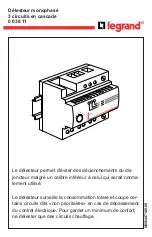
11
Overcurrent unit of SPCJ 4D29
Low-set overcurrent stage I >
Setting range
0.5...5.0 x I
n
Selectable modes of operation
- definite time operation
- operating time t>
0.05...300 s
- inverse definite minimum time (IDMT) mode
of operation as per IEC 60255-3 and BS 142
Extremely inverse
Very inverse
Normal inverse
Long-time inverse
- special type inverse characteristics
RI-type inverse
RXIDG-type inverse
- time multiplier k
0.05...1.0
High-set overcurrent stage I>>
Setting range
0.5...40 x I
n
and
∞
Operating time t>>
0.04...300 s
Note!
If the setting is higher than 2.5 x I
n
, the maximum continuous carry (4 x I
n
) and the levelling out
of the I.D.M.T -curves at high current levels must be noted.
Note!
The high-current end of any inverse time characteristic is determined by the high-set stage which,
when started, inhibits the low-set stage operation. The trip time is thus equal to the set t>> for any
current higher than I>>. In order to get a trip signal, the stage I>> must also of course be linked to
a trip output relay.
Earth-fault unit of SPCJ 4D29
Low-set neutral overcurrent stage I
0
>
Setting range
0.1...0.8 x I
n
Selectable modes of operation
- definite time operation
- operating time t
0
>
0.05...300 s
- inverse definite minimum time (IDMT) mode
of operation as per IEC 60255-3 and BS 142
Extremely inverse
Very inverse
Normal inverse
Long-time inverse
- special type inverse characteristics
RI-type inverse
RXIDG-type inverse
- time multiplier k
0
0.05...1.0
Note!
The high-current end of any inverse time characteristic is determined by the high-set stage which,
when started, inhibits the low-set stage operation. The trip time is thus equal to the set t
0
>> for
any current higher than I
0
>>. In order to get a trip signal, the stage I
0
>> must also of course be
linked to a trip output relay.
High-set neutral overcurrent stage I
0
>>
Setting range
0.1...10.0 x I
n
and
∞
Operating time t
0
>>
0.05... 300 s












































